Effect of Music Listening on Physiological Condition, Mental Workload, and Driving Performance with Consideration of Driver Temperament
Abstract
1. Introduction
2. Study Design
2.1. Participants
2.2. Music Genre
2.3. Driving Simulator Apparatus and Driving Scenario
2.4. Experimental Procedure
3. Method of Analysis
4. Results
4.1. Physiological State
4.1.1. Mean Heart Rate
4.1.2. Heart Rate Variability
4.2. Perceived Mental Workload
4.3. Driving Performance
5. Discussion
5.1. Effects of Music Genre
5.2. Effects of Driver Temperament
6. Conclusions
Author Contributions
Funding
Conflicts of Interest
References
- Brodsky, W. The effects of music tempo on simulated driving performance and vehicular control. Transp. Res. Part F Traffic Psychol. Behav. 2001, 4, 219–241. [Google Scholar] [CrossRef]
- Dibben, N.; Williamson, V.J. An exploratory survey of in-vehicle music listening. Psychol. Music 2007, 35, 571–589. [Google Scholar] [CrossRef]
- Van der Zwaag, M.D.; Dijksterhuis, C.; de Waard, D.; Mulder, B.L.; Westerink, J.H.; Brookhuis, K.A. The influence of music on mood and performance while driving. Ergonomics 2012, 55, 12–22. [Google Scholar] [CrossRef] [PubMed]
- Brodsky, W.; Slor, Z. Background music as a risk factor for distraction among young-novice drivers. Accid. Anal. Prev. 2013, 59, 382–393. [Google Scholar] [CrossRef] [PubMed]
- Stutts, J.; Feaganes, J.; Rodgman, E.; Hamlett, C.; Meadows, T.; Reinfurt, D.; Gish, K.; Mercadante, M.; Staplin, L. Distractions in Everyday Driving; AAA Foundation for Traffic Safety: Washington, DC, USA, 2003. [Google Scholar]
- Ünal, A.B.; de Waard, D.; Epstude, K.; Steg, L. Driving with music: Effects on arousal and performance. Transp. Res. Part F Traffic Psychol. Behav. 2013, 21, 52–65. [Google Scholar] [CrossRef]
- Ünal, A.B.; Steg, L.; Epstude, K. The influence of music on mental effort and driving performance. Accid. Anal. Prev. 2012, 48, 271–278. [Google Scholar] [CrossRef] [PubMed]
- Brodsky, W.; Kizner, M. Exploring an alternative in-car music background designed for driver safety. Transp. Res. Part F Traffic Psychol. Behav. 2012, 15, 162–173. [Google Scholar] [CrossRef]
- Shelton, L.R. Statement before the Subcommittee on Highways and Transit; The U.S. House Committee on Transportation and Infrastructure: Washington, DC, USA, 2001. [Google Scholar]
- Feng, Z.; Yang, M.; Kumfer, W.; Zhang, W.; Du, Y.; Bai, H. Effect of longitudinal slope of urban underpass tunnels on drivers’ heart rate and speed: A study based on a real vehicle experiment. Tunn. Undergr. Sp. Tech. 2018, 81, 525–533. [Google Scholar] [CrossRef]
- Xu, J.; Lin, W.; Wang, X.; Shao, Y.-M. Acceleration and deceleration calibration of operating speed prediction models for two-lane mountain highways. J. Transp. Eng. Part A 2017, 143, 04017024. [Google Scholar] [CrossRef]
- Strayer, D.L.; Johnston, W.A. Driven to Distraction: Dual-Task Studies of Simulated Driving and Conversing on a Cellular Telephone. Psychol. Sci. 2001, 12, 462–466. [Google Scholar] [CrossRef]
- Wiesenthal, D.L.; Hennessy, D.A.; Totten, B. The Influence of Music on Driver Stress 1. J. Appl. Soc. Psychol. 2000, 30, 1709–1719. [Google Scholar] [CrossRef]
- Cummings, P.; Koepsell, T.D.; Moffat, J.M.; Rivara, F.P. Drowsiness, counter-measures to drowsiness, and the risk of a motor vehicle crash. Inj. Prev. 2001, 7, 194. [Google Scholar] [CrossRef] [PubMed]
- Home, J.A.; Reyner, L.A. Evaluation of ‘In-Car’ Countermeasures to Sleepiness: Cold Air and Radio. Sleep 1998, 21, 46–51. [Google Scholar] [CrossRef]
- Wiesenthal, D.L.; Hennessy, D.A.; Totten, B. The influence of music on mild driver aggression. Transp. Res. Part F Traffic Psychol. Behav. 2003, 6, 125–134. [Google Scholar] [CrossRef]
- Pêcher, C.; Lemercier, C.; Cellier, J.-M. Emotions drive attention: Effects on driver’s behaviour. Saf. Sci. 2009, 47, 1254–1259. [Google Scholar] [CrossRef]
- Lyu, N.; Cao, Y.; Wu, C.; Xu, J.; Xie, L. The effect of gender, occupation and experience on behavior while driving on a freeway deceleration lane based on field operational test data. Accid. Anal. Prev. 2018, 121, 82–93. [Google Scholar] [CrossRef] [PubMed]
- Van der Zwaag, M.D.; Westerink, J.H.; van den Broek, E.L. Emotional and psychophysiological responses to tempo, mode, and percussiveness. Music. Sci. 2011, 15, 250–269. [Google Scholar] [CrossRef]
- Liu, J.; Tian, P.; Rong, J.; Ren, F.T. Initial Research on Relationship between Drivers’ Temperament and Travel Speed. J. B. Univ. Technol. 2006, 32, 27–32. [Google Scholar]
- Kagan, J.; Snidman, N.; Arcus, D.; Reznick, J.S. Galen’s Prophecy: Temperament in Human Nature; Basic Books: New York, NY, USA, 1994. [Google Scholar]
- Xiao, J.; Qin, Y.Q.; Wang, Y.Y.; Hai-Qiong, L.I. Research on the Relationship between the Driver’s Temperament and Driving Behavior. Chin. J. Ergon. 2014, 20, 23–27. [Google Scholar]
- Zhang, T.; Chen, H. Report on designing temperament testing questionnaire and its first application. J. Shanxi Univ. (Philos. Soc. Sci. Ed.) 1985, 4, 73–77. [Google Scholar]
- Shi, J.; Yao, X.; Chen, Z. Influence of Music Preference on Driving Behavior. J. Transp. Inf. Saf. 2014, 5, 52–57. [Google Scholar]
- BIOPAC. BIOPAC Systems, Inc. Available online: https://www.biopac.com/ (accessed on 1 May 2019).
- IBM Corp. SPSS Statistics for Windows, Version 22.0; IBM Corp.: Armonk, NY, USA, 2013. [Google Scholar]
- Huang, H.; Zeng, Q.; Pei, X.; Wong, S.C.; Xu, P. Predicting crash frequency using an optimised radial basis function neural network model. Transportmetrica A 2016, 12, 330–345. [Google Scholar] [CrossRef]
- Zeng, Q.; Huang, H.; Pei, X.; Wong, S.C. Modeling nonlinear relationship between crash frequency by severity and contributing factors by neural networks. Anal. Methods Accid. Res. 2016, 10, 12–25. [Google Scholar] [CrossRef]
- Zeng, Q.; Huang, H.; Pei, X.; Wong, S.C.; Gao, M. Rule extraction from an optimized neural network for traffic crash frequency modeling. Accid. Anal. Prev. 2016, 97, 87–95. [Google Scholar] [CrossRef]
- Zeng, Q.; Wen, H.; Huang, H.; Pei, X.; Wong, S.C. A multivariate random-parameters Tobit model for analyzing highway crash rates by injury severity. Accid. Anal. Prev. 2017, 99, 184–191. [Google Scholar] [CrossRef]
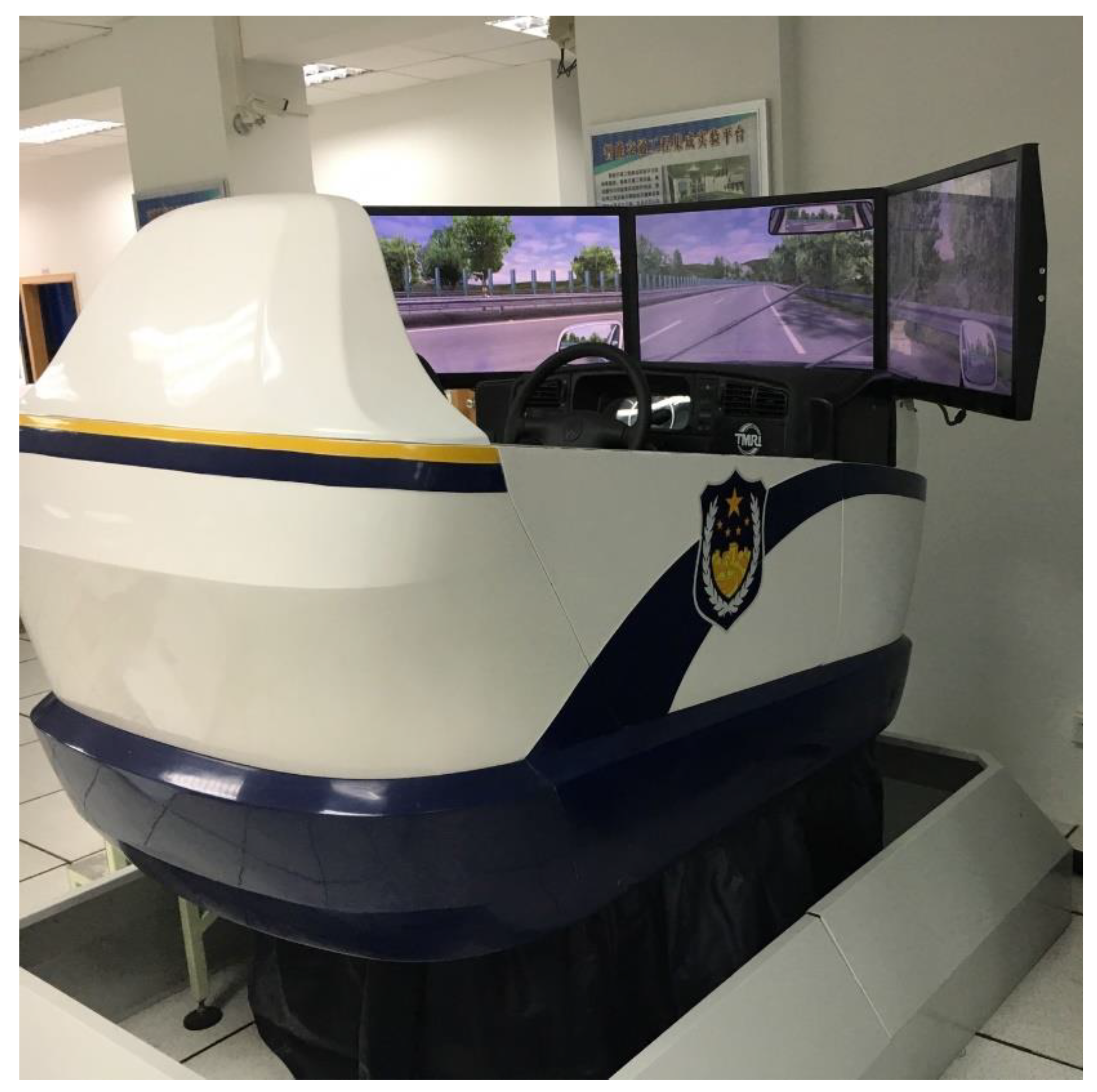
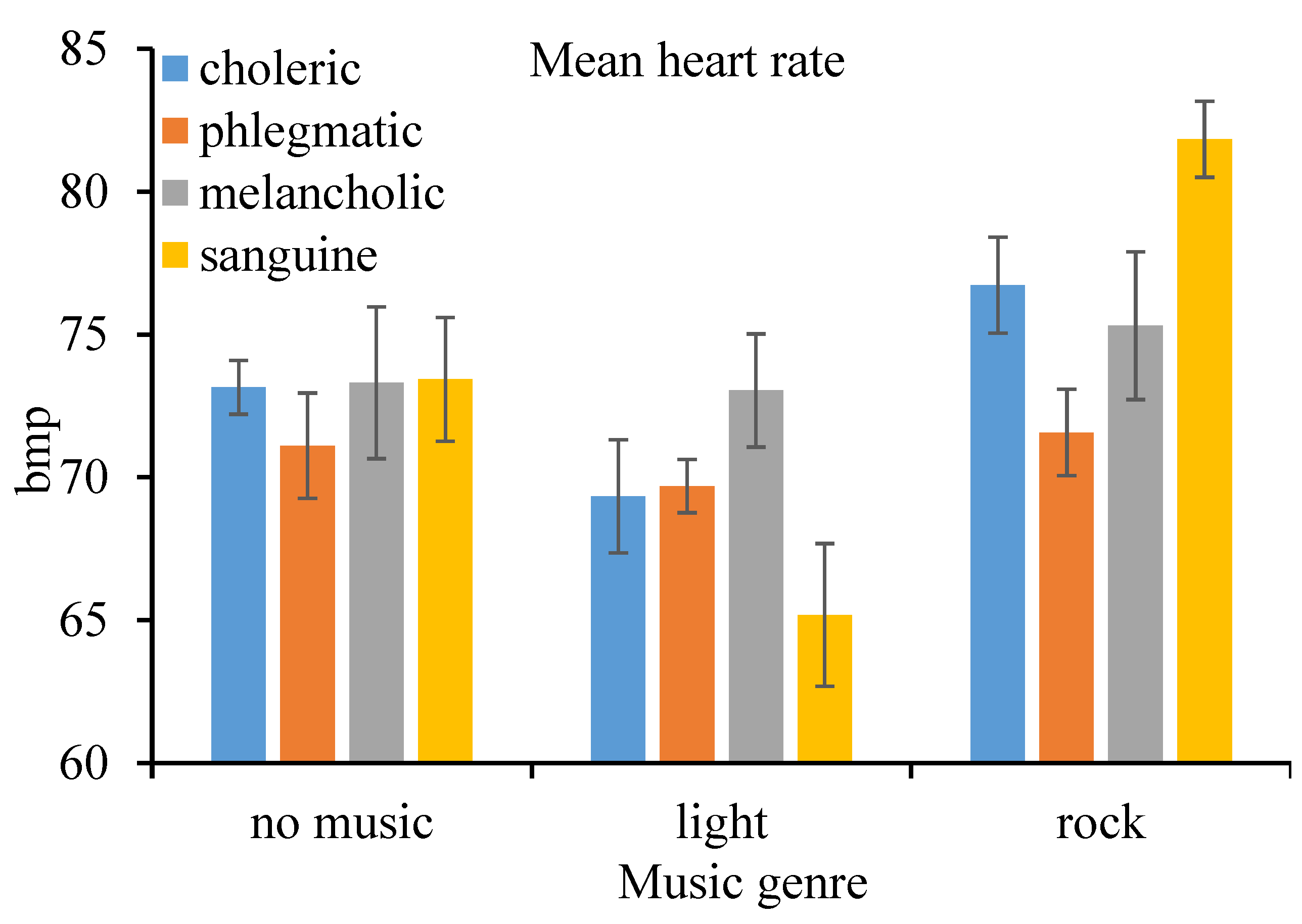
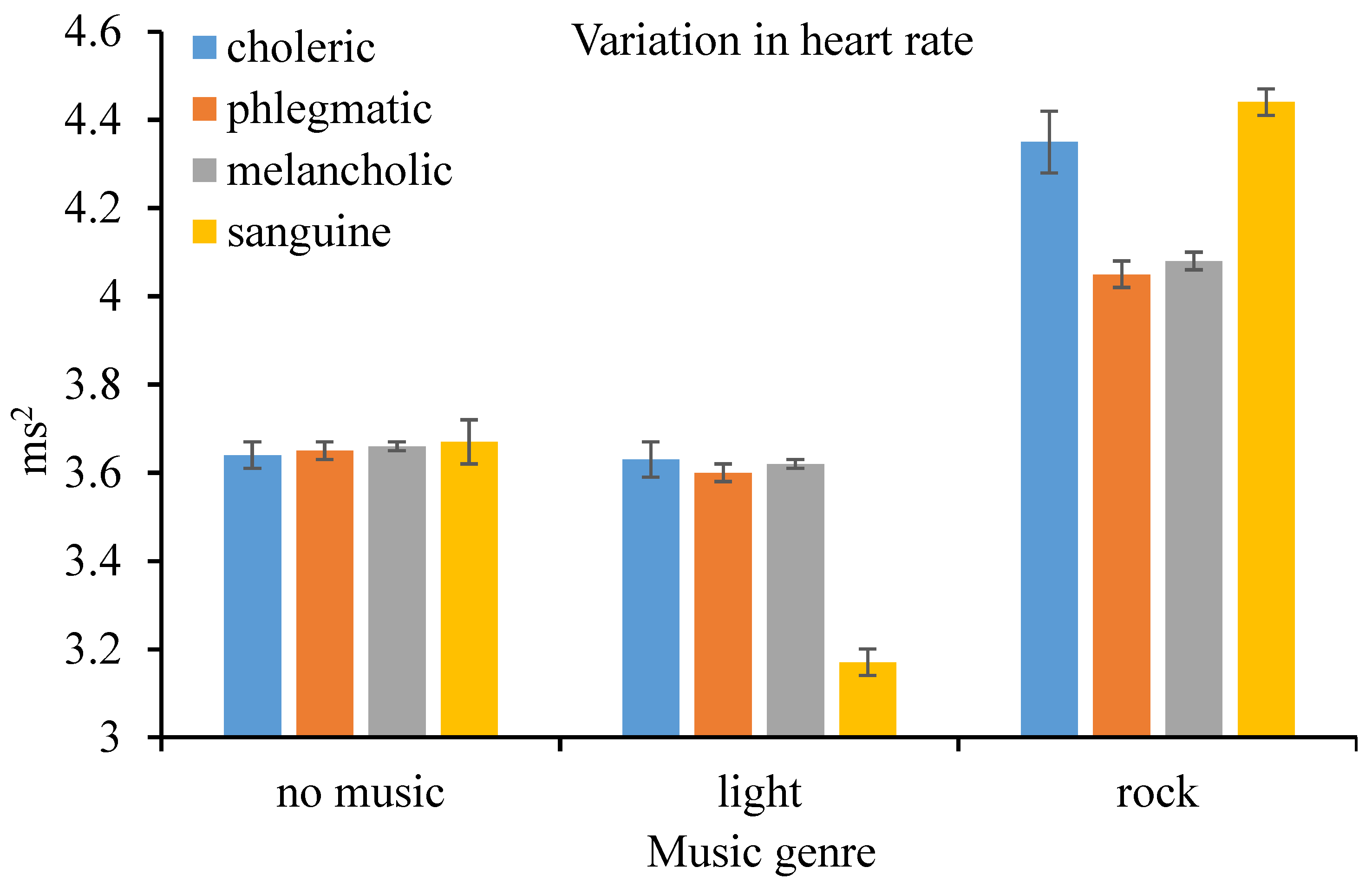
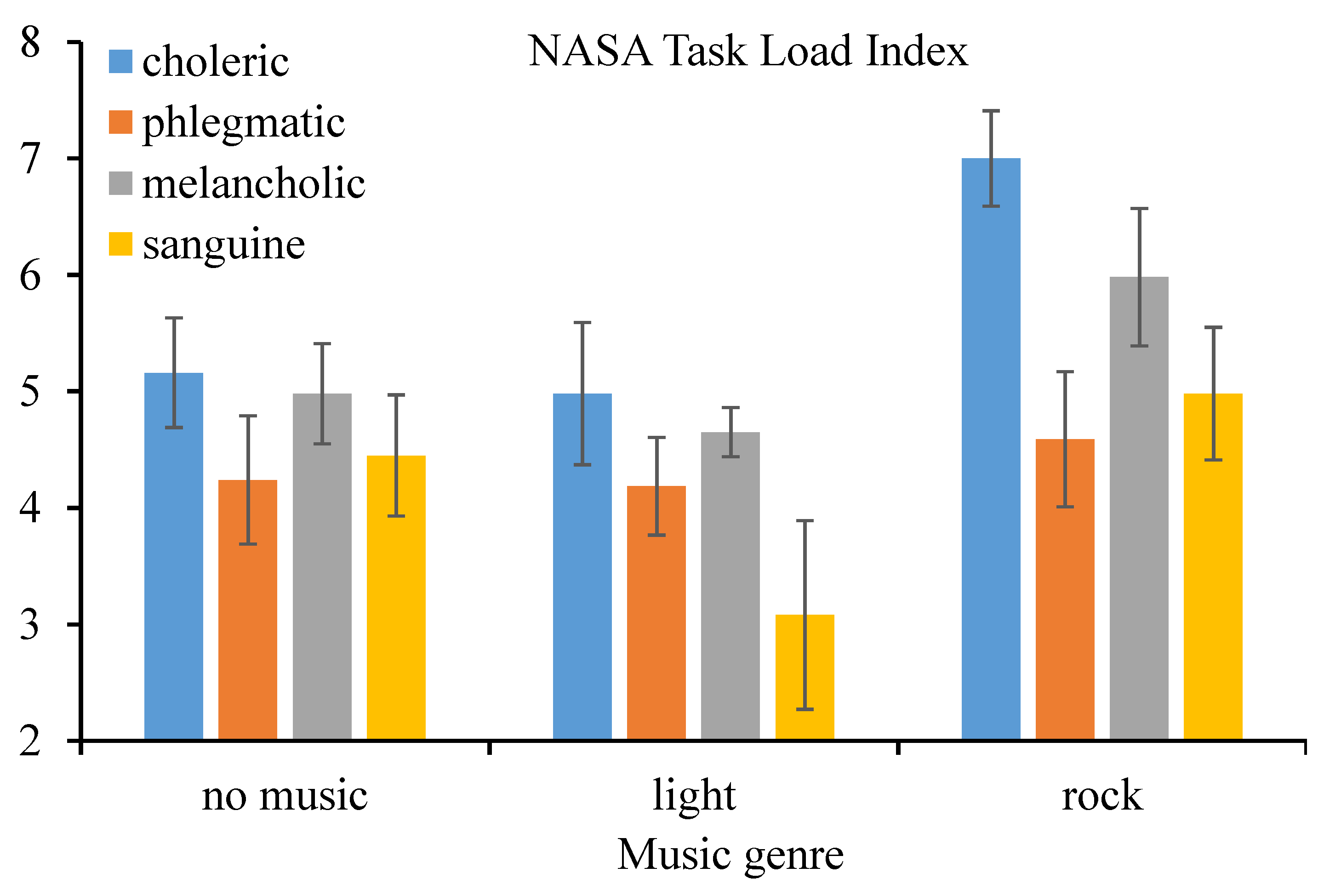
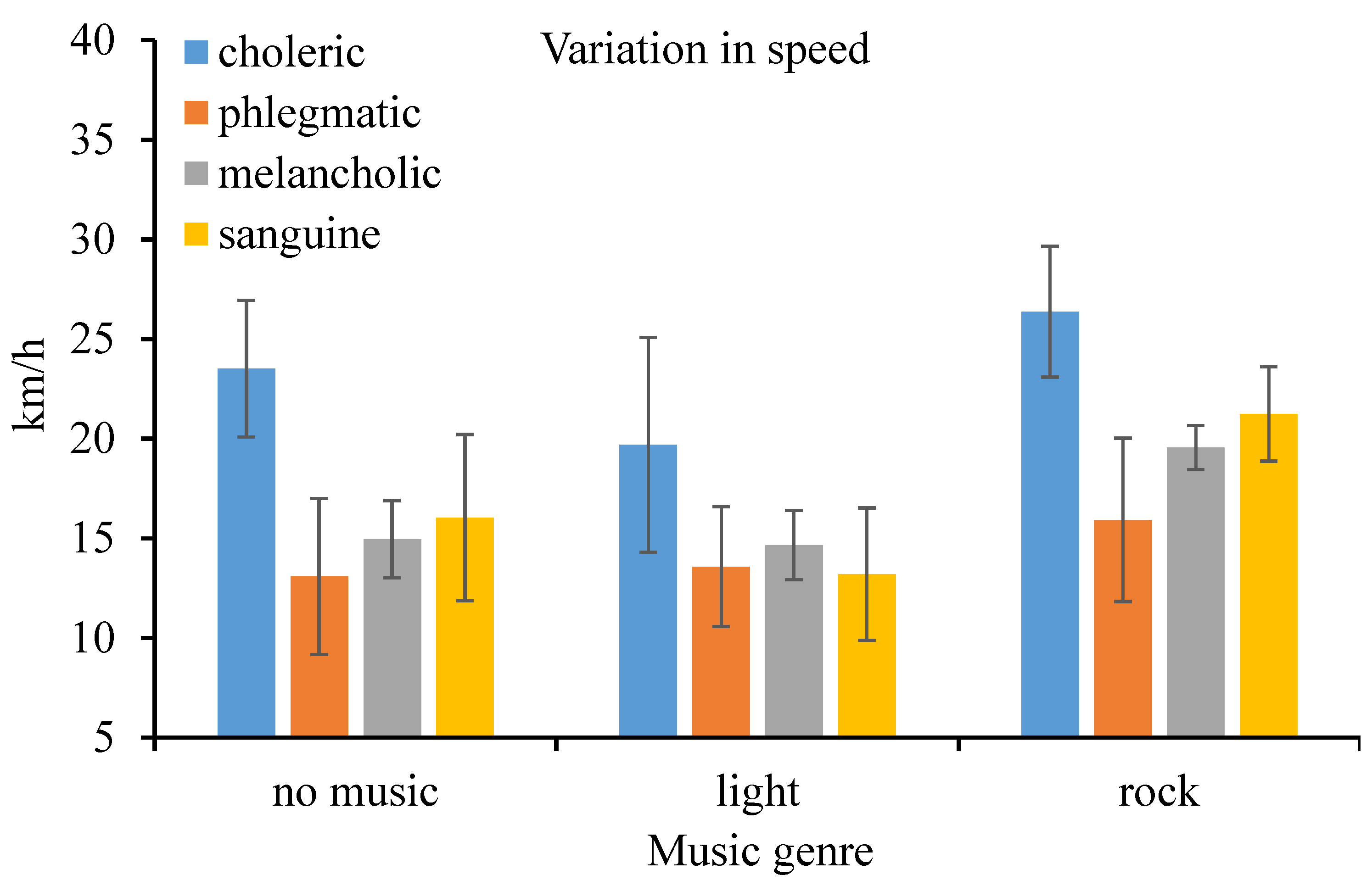
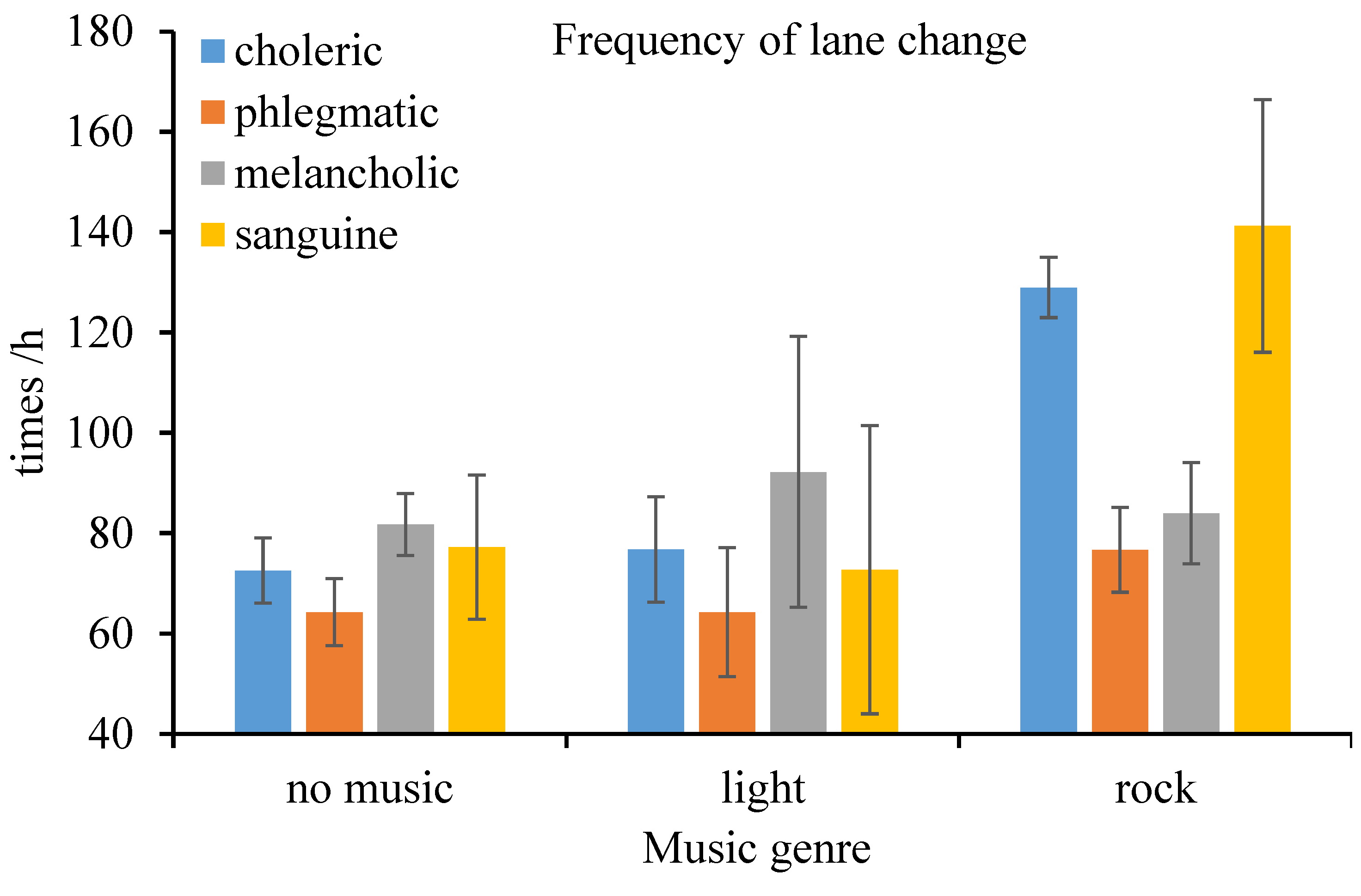
| Measure | Music Genre | Driver Temperament | Interaction between Music Genre and Driver Temperament | ||||||
|---|---|---|---|---|---|---|---|---|---|
| F(2, 32) | p | F(3, 16) | p | F(6, 32) | p | ||||
| Mean heart rate | 88.44 | <0.001 | 0.847 | 7.109 | 0.003 | 0.571 | 20.08 | <0.001 | 0.790 |
| Heart rate variability | 3108 | <0.001 | 0.995 | 14.25 | <0.001 | 0.728 | 170.2 | <0.001 | 0.970 |
| NASA-TLX | 211.7 | <0.001 | 0.930 | 10.0 | 0.001 | 0.652 | 29.33 | <0.001 | 0.846 |
| S.D. of speed | 30.05 | <0.001 | 0.653 | 9.495 | 0.001 | 0.640 | 1.444 | 0.229 | 0.213 |
| Lane crossing frequency | 47.88 | <0.001 | 0.750 | 8.021 | 0.002 | 0.601 | 11.97 | <0.001 | 0.692 |
© 2019 by the authors. Licensee MDPI, Basel, Switzerland. This article is an open access article distributed under the terms and conditions of the Creative Commons Attribution (CC BY) license (http://creativecommons.org/licenses/by/4.0/).
Share and Cite
Wen, H.; Sze, N.N.; Zeng, Q.; Hu, S. Effect of Music Listening on Physiological Condition, Mental Workload, and Driving Performance with Consideration of Driver Temperament. Int. J. Environ. Res. Public Health 2019, 16, 2766. https://doi.org/10.3390/ijerph16152766
Wen H, Sze NN, Zeng Q, Hu S. Effect of Music Listening on Physiological Condition, Mental Workload, and Driving Performance with Consideration of Driver Temperament. International Journal of Environmental Research and Public Health. 2019; 16(15):2766. https://doi.org/10.3390/ijerph16152766
Chicago/Turabian StyleWen, Huiying, N. N. Sze, Qiang Zeng, and Sangen Hu. 2019. "Effect of Music Listening on Physiological Condition, Mental Workload, and Driving Performance with Consideration of Driver Temperament" International Journal of Environmental Research and Public Health 16, no. 15: 2766. https://doi.org/10.3390/ijerph16152766
APA StyleWen, H., Sze, N. N., Zeng, Q., & Hu, S. (2019). Effect of Music Listening on Physiological Condition, Mental Workload, and Driving Performance with Consideration of Driver Temperament. International Journal of Environmental Research and Public Health, 16(15), 2766. https://doi.org/10.3390/ijerph16152766







